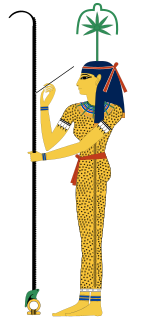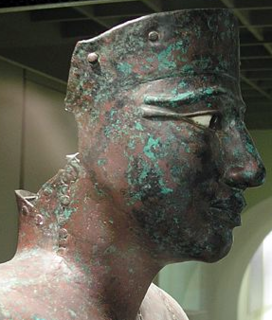
Pharaoh is the common title of the monarchs of ancient Egypt from the First Dynasty until the annexation of Egypt by the Roman Empire in 30 BCE, although the actual term "Pharaoh" was not used contemporaneously for a ruler until Merneptah, c. 1200 BCE. In the early dynasty, ancient Egyptian kings used to have up to three titles, the Horus, the Sedge and Bee (nswt-bjtj) name, and the Two Ladies (nbtj) name. The Golden Horus and nomen and prenomen titles were later added.

Amunet or Imnt ; also spelled Amonet or Amaunet; Koinē Greek: Αμαυνι) is a primordial goddess in ancient Egyptian religion. Thebes was the center of her worship through the last dynasty, the Ptolemaic Kingdom, in 30 BC. She is attested in the earliest known of Egyptian religious texts and, as was the custom, was paired with a counterpart who is entitled with the same name, but in the masculine. They were thought to have existed prior to the beginning of creation along with three other couples representing primeval concepts.

Seshat, under various spellings, was the ancient Egyptian goddess of wisdom, knowledge, and writing. She was seen as a scribe and record keeper, and her name means she who scrivens, and is credited with inventing writing. She also became identified as the goddess of accounting, architecture, astronomy, astrology, building, mathematics, and surveying.

The ankh or key of life is an ancient Egyptian hieroglyphic symbol that was most commonly used in writing and in Egyptian art to represent the word for "life" and, by extension, as a symbol of life itself.

Amenhotep III, also known as Amenhotep the Magnificent, was the ninth pharaoh of the Eighteenth Dynasty. According to different authors, he ruled Egypt from June 1386 to 1349 BC, or from June 1388 BC to December 1351 BC/1350 BC, after his father Thutmose IV died. Amenhotep III was Thutmose's son by a minor wife, Mutemwiya.

Pepi I Meryre was the third king of the Sixth Dynasty of Egypt, ruling for over 40 years during the second half of the 24th Century BC, toward the end of the Old Kingdom period. Pepi I was the son of his second predecessor Teti, ascending the throne only after the brief and enigmatic reign of the shadowy Userkare. Pepi's mother was queen Iput, who may have been a daughter of Unas, final ruler of the Fifth Dynasty of Egypt.

The Sed festival was an ancient Egyptian ceremony that celebrated the continued rule of a pharaoh. The name is taken from the name of an Egyptian wolf god, one of whose names was Wepwawet or Sed.

Den, also known as Hor-Den, Dewen and Udimu, is the Horus name of a pharaoh of the Early Dynastic Period who ruled during the First Dynasty of Egypt. He is the best archaeologically-attested ruler of this period. Den is said to have brought prosperity to his realm and numerous innovations are attributed to his reign. He was the first to use the title "King of Lower and Upper Egypt", and the first depicted as wearing the double crown. The floor of his tomb at Umm El Qa'ab near Abydos is made of red and black granite, the first time in Egypt this hard stone was used as a building material. During his long reign he established many of the customs of court ritual and royalty used by later rulers and he was held in high regard by his immediate successors.

Scorpion II, also known as King Scorpion, was a ruler during the Protodynastic Period of Upper Egypt.

Deshret, from Ancient Egyptian, was the formal name for the Red Crown of Lower Egypt and for the desert Red Land on either side of Kemet, the fertile Nile river basin. When combined with the Hedjet of Upper Egypt, it forms the Pschent, in ancient Egyptian called the sekhemti.
Jürgen von Beckerath was a German Egyptologist. He was a prolific writer who published countless articles in journals such as Orientalia, Göttinger Miszellen (GM), Journal of the American Research Center in Egypt (JARCE), Archiv für Orientforschung (AfO), and Studien zur Altägyptischen Kultur (SAK) among others. Together with Kenneth Kitchen, he is viewed as one of the foremost scholars on the New Kingdom and the Third Intermediate Period of Egypt.

Anedjib, more correctly Adjib and also known as Hor-Anedjib, Hor-Adjib and Enezib, is the Horus name of an early Egyptian king who ruled during the 1st Dynasty. The Egyptian historian Manetho named him "Miebîdós" and credited him with a reign of 26 years, whilst the Royal Canon of Turin credited him with an implausible reign of 74 years. Egyptologists and historians now consider both records to be exaggerations and generally credit Adjib with a reign of 8–10 years.

The block statue is a type of memorial statue that first emerged in the Middle Kingdom of Egypt. The block statue grew in popularity in the New Kingdom and the Third Intermediate Period, and by the Late Period, this type of statue was the most common. These statues were used in temples typically as funerary monuments of non-royal yet important individuals. According to primary sources from the New Kingdom, the posture of the statue was possibly intended to resemble a guardian seated in the gateway of a temple. In addition, their simple shape provided ample flat surfaces for inscriptions of offerings and invocations.
The ancient Egyptian papyrus stem hieroglyph is one of the oldest language hieroglyphs from Ancient Egypt. The papyrus stalk, was incorporated into designs of columns on buildings, also facades, and is also in the iconographic art portrayed in Ancient Egyptian decorated scenes.
The pectorals of ancient Egypt were a form of jewelry, often represented as a brooch. These were mostly worn by richer people and the pharaoh.
In ancient Egyptian art, the Set animal, or sha, is the totemic animal of the god Set. Because Set was identified with the Greek Typhon, the animal is also commonly known as the Typhonian animal or Typhonic beast.
Articles related to ancient Egypt include:
A coronation was an extremely important ritual in early and ancient Egyptian history, concerning the change of power and rulership between two succeeding pharaohs. The accession to the throne was celebrated in several ceremonies, rites and feasts.
















